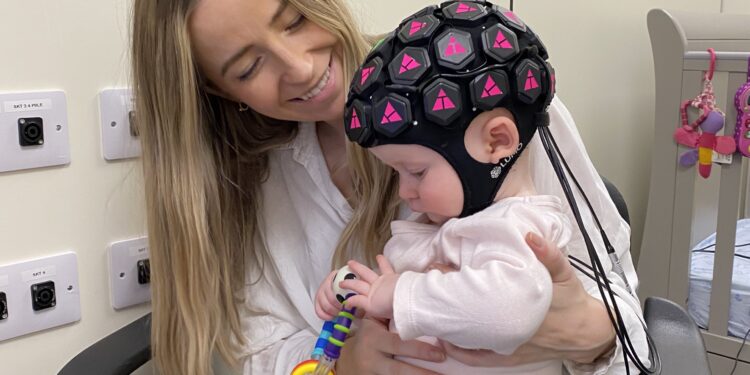Mother Mererid and baby Mabli were volunteers for the study. Credit: Liam Collins-Jones/UCL
New technology that uses harmless light waves to measure brain activity in babies has provided the most comprehensive picture yet of brain functions such as hearing, vision and cognitive processing outside of a conventional, restrictive brain scan, in a new study led by researchers from UCL and Birkbeck.
The wearable brain imaging headset, developed in collaboration with UCL spin-off Gowerlabs, detected unexpected activity in the prefrontal cortex, an area of the brain that processes emotions, in response to social stimuli, suggesting that babies begin to process what happens to them in social situations as early as five months old.
This cutting-edge technology can measure neural activity across the entire outer surface of a baby’s brain. An earlier version developed by the same team could only measure activity in one or two parts of a baby’s brain at a time.
Researchers say the technology could help map connections between different brain regions and establish what distinguishes typical and atypical neurodevelopment in the crucial early stages of childhood and shed light on neurodiverse conditions such as autism, dyslexia and ADHD.
The development of the new device and the results of the first tests are documented in a study, published in Imaging in neuroscience.
Dr Liam Collins-Jones, first author of the study from UCL Medical Physics & Biomedical Engineering and the University of Cambridge, said: “We have already developed a wearable imaging approach that could map activity in specific areas of the brain.
“But this made it difficult to get a complete picture because we could only focus on one or two areas in isolation, when in reality different parts of the brain work together to navigate real-world scenarios.
“The new method allows us to look at what’s happening across the entire outer surface of the brain beneath the scalp, which is a big step forward. It opens up possibilities for spotting interactions between different areas and detecting activity in areas we might not have been able to see before.
“This more complete picture of brain activity could improve our understanding of how babies’ brains work as they interact with the world around them, which could help us optimize support for neurodiverse children from an early age.”
Professor Emily Jones, lead author of the study at Birkbeck, University of London, said: “This is the first time that differences in activity across such a large area of the brain have been measured in babies using a wearable device, including parts of the brain involved in processing sound, vision and emotion.
“The technology developed and tested in this study is a stepping stone toward a better understanding of the brain processes underlying social development that we have not been able to observe before, outside the very restrictive confines of an MRI scanner.
“With this, we should be able to see what’s happening in babies’ brains when they play, learn and interact with other people in a very natural way.”
The new device was tested on 16 babies aged five to seven months. The babies sat on their parents’ laps and were shown videos of actors singing nursery rhymes to imitate a social scenario, and videos of moving toys, such as a ball rolling down a ramp, to imitate a non-social scenario.
The researchers observed differences in brain activity between the two scenarios. In addition to the unexpected results observed in the prefrontal cortex in response to social stimuli, the researchers found that activity was more localized in response to social stimuli than to non-social stimuli, validating previous findings from optical neuroimaging and MRI studies.
Currently, the most comprehensive method for seeing what’s going on in the human brain is magnetic resonance imaging (MRI), which involves leaving the subject still in the scanner for potentially 30 minutes or more.
The downside to this approach is that it is difficult to mimic natural scenarios, such as interacting with another person or performing a task, especially with infants who would need to be asleep or restrained for an MRI to successfully image their brain activity.
To address this problem, in recent years this team of researchers has used a form of optical neuroimaging, called high-density diffuse optical tomography (HD-DOT), to develop portable devices that can study brain activity in a more natural way. This technology also has the advantage of being cheaper and more portable than MRI.
In the new study, the researchers developed an HD-DOT optical neuroimaging method capable of scanning the entire infant head.
The device used in the study was adapted from a commercial system developed by Gowerlabs, a UCL spin-off company founded in 2013 by researchers from UCL’s Biomedical Optics Research Laboratory.
Dr Rob Cooper, lead author of the study from UCL Medical Physics & Biomedical Engineering, said: “This device is a great example of academic research and commercial technology development working hand in hand.
“The long-standing collaboration between UCL and Gowerlabs, together with our academic partners, has been fundamental to the development of the HD-DOT wearable technology.”
Dr Collins-Jones will give a talk about this research at the British Science Festival on Saturday 14 September.
More information:
Liam H. Collins-Jones et al., Whole-head high-density diffuse optical tomography to map infants’ audiovisual responses to social and nonsocial stimuli, Imaging in neuroscience (2024). DOI: 10.1162/imag_a_00244
Provided by University College London
Quote:Wearable brain imaging device sheds light on how babies react in real-world situations (2024, September 10) retrieved September 11, 2024 from
This document is subject to copyright. Apart from any fair dealing for the purpose of private study or research, no part may be reproduced without written permission. The content is provided for informational purposes only.



